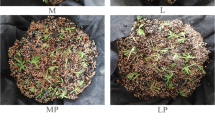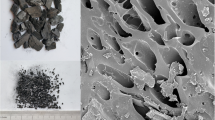Abstract
Due to substrate layers with different substrate configurations, extensive green roofs (EGRs) exhibit different rainfall runoff retention and pollution interception effects. In the rainfall runoff scouring process, nutrient leaching often occurs in the substrate layer, which becomes a pollution source for rainwater runoff. In this study, six EGR devices with different substrate layer configurations were fabricated. Then, the cumulative leaching quantity (CLQ) and total leaching rate (TLR) of NH4+, TN, and TP in the outflow of nine different depth simulated rainfall events under local rainfall characteristics were evaluated and recorded. Furthermore, the impact of different substrate configurations on the pollution interception effects of EGRs for rainfall runoff was studied. Results show that a mixed adsorption substrate in the EGR substrate layer has a more significant rainfall runoff pollution interception capacity than a single adsorption substrate. PVL and PVGL, as EGRs with layered configuration substrate layers, exhibited good NH4+-N interception capacity. The CLQ and TLR of NH4+-N for PVL and PVGL were − 114.613 mg and − 63.43%, − 121.364 mg, and − 67.16%, respectively. Further, the addition of biochar as a modifier significantly slowed down the substrate layer TP leaching effect and improved the interception effect of NH4+-N and TN. Moreover, although polyacrylamide addition in the substrate layer aggravated the nitrogen leaching phenomenon in the EGRs’ outflow, but the granular structure substrate layer constructed by it exhibited a significantly inhibited TP leaching effect.






Similar content being viewed by others
Availability of data and materials
The datasets used and analyzed during the current study are available from the corresponding author on reasonable request.
References
Abualfaraj N, Cataldo J, Elborolosy Y, Fagan D, Woerdeman S, Carson T, Montalto FA (2018) Monitoring and modeling the long-term rainfall-runoff response of the Jacob K. Javits Center Green Roof Water 10(11):1494
Ao C, Zeng WZ, Yang PL, Xing WM, Lei GQ, Wu JW, Huang JS (2021) The effects of slope shape and polyacrylamide application on runoff, erosion and nutrient loss from hillslopes under simulated rainfall. Hydrol Process 35(4):e14130
Chai HX, Tang Y, Su XJ, Wang WJ, Lu H, Shao ZY, He Q (2018) Annual variation patterns of the effluent water quality from a green roof and the overall impacts of its structure. Environ Sci Pollut Res 25(30):30170–30179
Chen HM, Ma JY, Wei JX, Gong X, Yu XC, Guo H, Zhao YW (2018) Biochar increases plant growth and alters microbial communities via regulating the moisture and temperature of green roof substrates. Sci Total Environ 635:333–342
Chen HM, Du XF, Lai MQ, Nazhafati M, Li C, Qi WC (2021) Biochar improves sustainability of green roofs via regulate of soil microbial communities. Agriculture 11(7):620
Deska I, Mrowiec M, Ociepa E, Lacisz K (2018) Investigation of the influence of hydrogel amendment on the retention capacities of green roofs. Ecol Chem Eng S 25(3):373–382
Eksi M, Rowe DB (2016) Green roof substrates: effect of recycled crushed porcelain and foamed glass on plant growth and water retention. Urban Forestry & Urban Greening 20:81–88
Gong YW, Yin DK, Fang X, Li JQ (2018a) Factors affecting runoff retention performance of extensive green roofs. Water 10(9):1217
Gong YW, Yin DK, Fang X, Zhai DD, Li JQ (2018b) Rainwater retention effect of extensive green roofs monitored under natural rainfall events–a case study in Beijing. Hydrol Res 49(6):1773–1787
Gong YW, Yin DK, Li JQ, Zhang XW, Wang WH, Fang X, Shi HH, Wang Q (2019) Performance assessment of extensive green roof runoff flow and quality control capacity based on pilot experiments. Sci Total Environ 687:505–515
Guo JK, Zhang YT, Che SQ (2018) Performance analysis and experimental study on rainfall water purification with an extensive green roof matrix layer in Shanghai. China Water Science and Technology 77(3):670–681
Hill J, Sleep B, Drake J, Fryer M (2019) The effect of intraparticle porosity and interparticle voids on the hydraulic properties of soilless media. Vadose Zone Journal 18:1–13
Hoeben AD, Posch A (2021) Green roof ecosystem services in various urban development types: a case study in Graz, Austria. Urban For Urban Green 62:127167. https://doi.org/10.1016/j.ufug.2021.127167
Huang YY, Chen CT, Liu WT (2018) Thermal performance of extensive green roofs in a subtropical metropolitan area. Energy and Buildings 159:39–53
Huang S, Garg A, Mei GX, Huang DS, Chandra RB, Sadasiv SG (2020) Experimental study on the hydrological performance of green roofs in the application of novel biochar. Hydrol Process 34(23):4512–4525
Karczmarczyk A, Bus A, Baryła A (2018) Phosphate leaching from green roof substrates—can green roofs pollute urban water bodies? Water 10(2):199
Liu W, Feng Q, Chen WP, Wei W, Deo RC (2019) The influence of structural factors on stormwater runoff retention of extensive green roofs: new evidence from scale-based models and real experiments. J Hydrol 569:230–238
Liu ZH, Xu C, Cai GJ, Su JZ, Zhang CZ (2021) Experimental evaluation of the rainfall retention and inorganic pollutant mitigation effect by dual-layer and polyacrylamide-modified green roofs. Environ Sci Pollut Res. https://doi.org/10.1007/s11356-021-15267-6
Liu HQ, Yin HW, Kong FH, Middel A, Zheng XD, Huang J, Sun T, Wang D, Lensky IM (2022) Change of nutrients, microorganisms, and physical properties of exposed extensive green roof substrate. Sci Total Environ 805:150344
Ouyang W, Huang WJ, Peng W, Hao FH, Yu YY (2016) Optimization of typical diffuse herbicide pollution control by soil amendment configurations under four levels of rainfall intensities. J Environ Manage 175:1–8
Piscitelli L, Rivier PA, Mondelli D, Miano T, Joner EJ (2018) Assessment of addition of biochar to filtering mixtures for potential water pollutant removal. Environ Sci Pollut Res 25:2167–2174
Santos PLFD, Castilho RMMD (2018) Floriferous herbaceous and substrates for use on extensive green roofs. Ornamental Horticulture 24(3):275–282
Sepaskhah AR, Shahabizad V (2010) Effects of water quality and pam application rate on the control of soil erosion, water infiltration and runoff for different soil textures measured in a rainfall simulator. Biosys Eng 106(4):513–520
Shafique M, Kim R, Kyung-Ho K (2018) Green roof for stormwater management in a highly urbanized area: the case of Seoul. Korea Sustainability 10(3):584
Soinne H, Hovi J, Tammeorg P, Turtola E (2014) Effect of biochar on phosphorus sorption and clay soil aggregate stability. Geoderma 219–220:162–167
Thuring CE, Dunnett NP (2019) Persistence, loss and gain: characterising mature green roof vegetation by functional composition. Landsc Urban Plan 185:228–236
Todorov D, Driscoll CT, Todorova S (2018a) Long-term and seasonal hydrologic performance of an extensive green roof. Hydrol Process 32:2471–2482
Todorov D, Driscoll CT, Todorova S, Montesdeoca M (2018b) Water quality function of an extensive vegetated roof. Sci Total Environ 625:928–939
Tran S, Lundholm JT, Staniec M, Robinson CE, Smart CC, Voogt JA, O’Carroll DM (2019) Plant survival and growth on extensive green roofs: a distributed experiment in three climate regions. Ecol Eng 127:494–503
Tuttolomondo T, Fascella G, Licata M, Schicchi R, Gennaro MC, La Bella S, Leto C, Aprile S (2018) Studies on sedum taxa found in Sicily (Italy) for Mediterranean extensive green roofs. Ital J Agron 13:1077
Vijayaraghavan K, Reddy DHK, Yun YS (2019) Improving the quality of runoff from green roofs through synergistic biosorption and phytoremediation techniques: a review. Sustainable Cities and Society 46:101381
Wang XO, Tian YM, Zhao XH (2017) The influence of dual-substrate-layer extensive green roofs on rainwater runoff quantity and quality. Sci Total Environ 592:465–476
Wang J, Garg A, Huang S, Wu ZW, Wang TC, Mei GX (2021) An experimental and numerical investigation of the mechanism of improving the rainwater retention of green roofs with layered soil. Environ Sci Pollut Res. https://doi.org/10.1007/s11356-021-16369-x
Werdin J, Conn R, Fletcher TD, Rayner JP, Williams N, Farrell C (2021). Biochar particle size and amendment rate are more important for water retention and weight of green roof substrates than differences in feedstock type. Ecol Eng 171:106391
Xu C, Liu ZH, Cai GJ, Zhan J (2021) Experimental study on the selection of common adsorption substrates for extensive green roofs (EGRs). Water Sci Technol 83(4):961–974
Zhang W, Zhong X, Che W (2018) Nutrient leaching from extensive green roofs with different substrate compositions: a laboratory study. Water Sci Technol 77(3–4):1007–1014
Zhang QQ, Miao LP, Wang HW, Wang L (2019) Analysis of the effect of green roof substrate amended with biochar on water quality and quantity of rainfall runoff. Environ Monit Assess 191:304
Zhou DM, Liu YX, Hu SS, Hu DY, Neto S, Zhang Y (2019) Assessing the hydrological behaviour of large-scale potential green roofs retrofitting scenarios in Beijing. Urban Forestry & Urban Greening 40:105–113
Funding
This work was supported by the Special Fund for Postgraduate Innovation in Jiangxi Province, China (Grant No. YC2020-S125), and the Postgraduate Innovation Project of Nanchang University, China (Grant No. CX2019115).
Author information
Authors and Affiliations
Contributions
All the authors contributed to the study conception and design. Material preparation, data collection and analysis, and table and figure drawing were performed by Chen Xu, Zaohong Liu, and Guanjun Cai. The first draft of the manuscript was written by Chen Xu, and all the authors commented on previous versions of the manuscript. Jian Zhan revised the manuscript critically for important intellectual content. All the authors read and approved the final manuscript.
Corresponding author
Ethics declarations
Ethics approval and consent to participate
Not applicable.
Consent for publication
Not applicable.
Competing interests
The authors declare no competing interests.
Additional information
Responsible Editor: Philippe Garrigues
Publisher's note
Springer Nature remains neutral with regard to jurisdictional claims in published maps and institutional affiliations.
Highlights
• Multiple adsorption substrates have a synergistic effect on the adsorption and interception of pollutants.
• Layered substrate layer have significant NH4+-N interception capacity due to the unique lower adsorption layer.
• The addition of polyacrylamide in EGR substrate layer is likely to cause additional nitrogen pollution.
• Biochar can be used as an excellent modifier to enhance the rainfall runoff pollution interception capacity of EGRs.
Rights and permissions
About this article
Cite this article
Xu, C., Liu, Z., Cai, G. et al. Nutrient leaching in extensive green roof substrate layers with different configurations. Environ Sci Pollut Res 29, 34278–34287 (2022). https://doi.org/10.1007/s11356-021-17969-3
Received:
Accepted:
Published:
Issue Date:
DOI: https://doi.org/10.1007/s11356-021-17969-3




